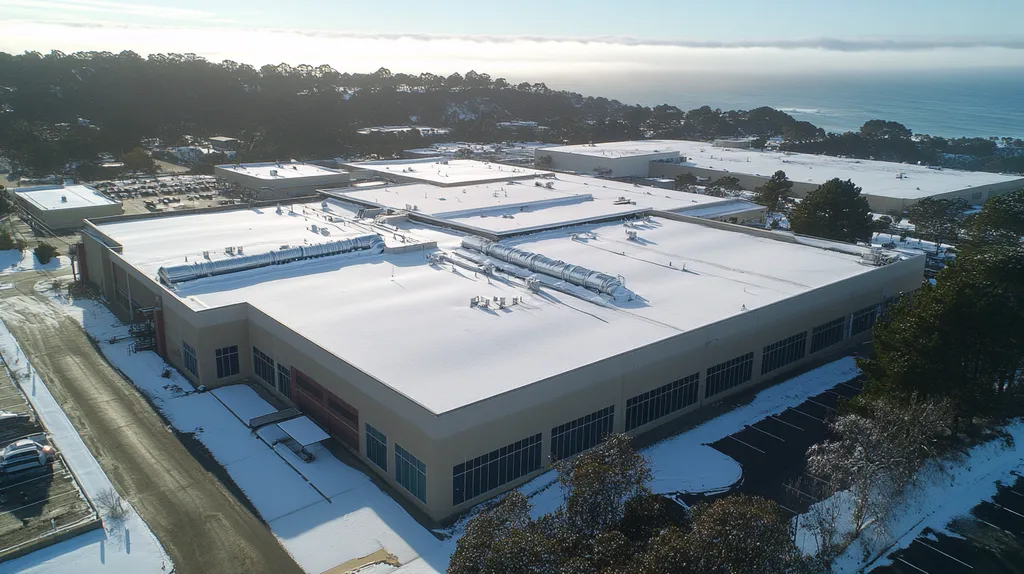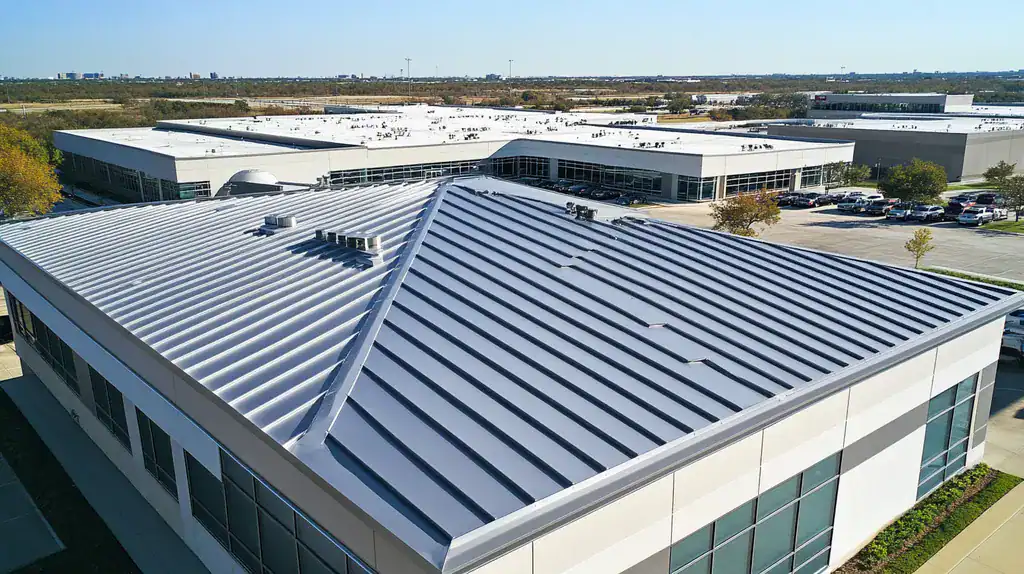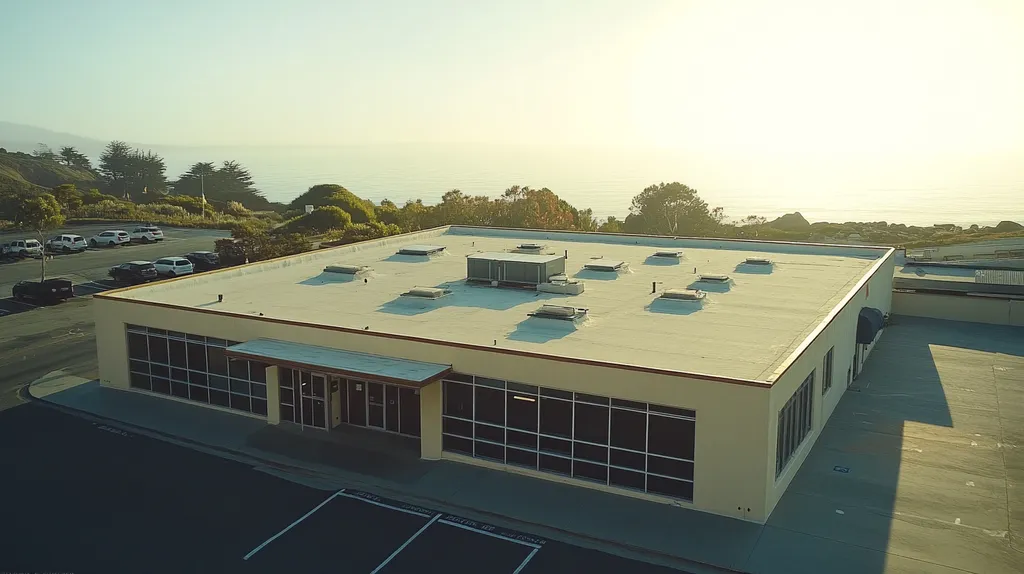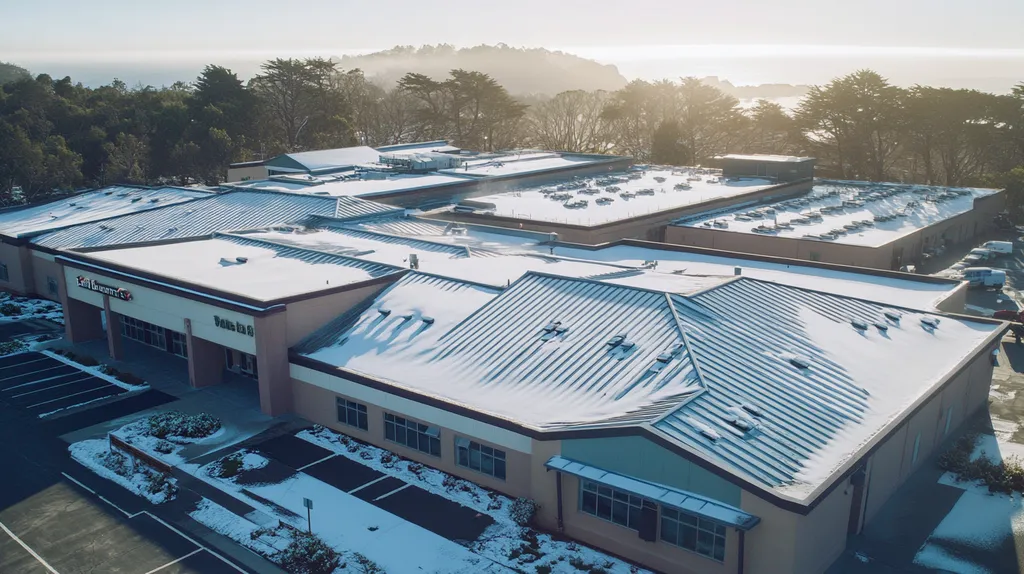Welcome to today’s Battle Royale featuring two roofing heavyweights: “Polyurethane Coatings” in the east corner versus “Silicone Coatings” in the west!
Tonight’s showdown pits these contenders against each other across six punishing rounds designed to test every aspect of their performance for Industrial Roof Coating Budget Optimization.
At stake? Millions in potential costs, decades of building protection, and the critical performance demands of modern commercial and industrial facilities.
Our professional judging panel will evaluate each round on technical merit, real-world performance, and value delivery. After all six rounds, we’ll declare our ultimate champion.
Ladies and gentlemen, facility managers and building owners… it’s time to rumble!
ROUND 1: INITIAL COSTS & INSTALLATION
In today’s volatile market, industrial roof coating decisions can impact a facility’s bottom line by tens of thousands of dollars annually. Property owners face mounting pressure to balance immediate budget constraints against long-term performance requirements. The selection between polyurethane and silicone coatings represents a critical financial decision point where material costs, installation requirements, and project efficiency converge.
Material Expenses
When evaluating coating materials, the price per square foot tells only part of the story. Initial material costs must be weighed against coverage rates, required thickness, and the number of coats needed for proper protection.
Polyurethane coatings command premium pricing, typically ranging 20-30% higher than alternatives. However, their superior tensile strength and abrasion resistance often translate to extended service life and reduced maintenance frequency.
Silicone coatings present a more economical initial investment, with material costs averaging significantly lower per square foot. Their single-coat application potential can further reduce material requirements compared to multi-coat polyurethane systems.
For pure material cost considerations, silicone coatings claim the “ADVANTAGE” due to lower upfront expenses and simplified material requirements.
Installation Complexity
Installation procedures directly impact labor costs and project success rates. Complex application requirements can multiply installation expenses and introduce quality control challenges.
Polyurethane systems demand precise surface preparation and environmental conditions. Their application requires skilled technicians and careful monitoring of ambient temperature, humidity, and dew point throughout the installation process.
Silicone coatings offer more forgiving application parameters and can be installed in a broader range of weather conditions. Their simpler installation process reduces the likelihood of application errors and typically requires less specialized training for installation crews.
The clear “ADVANTAGE” goes to silicone coatings for their streamlined installation requirements and reduced technical demands.
Project Timeline
Time is money in industrial roofing projects, where facility downtime can cost thousands per day. Efficient project execution becomes a crucial factor in total project economics.
Polyurethane coating installations typically require longer project timelines due to multiple coat applications and extended cure times between layers. Weather dependencies can further extend completion schedules.
Silicone coatings generally allow for faster project completion through single-coat applications and shorter cure times. Their moisture-tolerant nature means fewer weather-related delays and more predictable project schedules.
Given their faster installation and reduced schedule risks, silicone coatings secure the “ADVANTAGE” in project timeline considerations.
ROUND 1 WINNER: SILICONE COATINGS
ROUND 2: DURABILITY & LIFESPAN
Every year, industrial facilities lose millions in productivity due to roof coating failures and unexpected repairs. The choice between polyurethane and silicone coatings directly impacts maintenance cycles, repair frequency, and total ownership costs. Understanding how these materials perform over time is crucial for protecting both the facility and its operational budget.
Impact Resistance
Industrial roofs face constant stress from maintenance traffic, equipment vibration, and environmental impacts. The coating’s ability to withstand these forces directly affects its protective capabilities and lifespan.
Polyurethane coatings excel in impact resistance, maintaining their protective properties even under heavy foot traffic and mechanical stress. Their superior tensile strength and elasticity allow them to absorb impacts without cracking or separating from the substrate.
Silicone coatings demonstrate lower impact resistance and can show premature wear in high-traffic areas. Their softer composition makes them more susceptible to mechanical damage and punctures.
For impact resistance, polyurethane coatings claim the clear “ADVANTAGE” due to superior mechanical properties.
Weather Resistance
Extreme weather conditions test coating integrity through temperature cycles, UV exposure, and moisture penetration. The coating’s weather resistance directly influences its protective lifespan.
Polyurethane coatings maintain consistent performance across temperature extremes but can be vulnerable to standing water. Their multi-layer application creates excellent UV protection and weather barrier properties.
Silicone coatings demonstrate exceptional resistance to ponding water and UV exposure. Their single-layer application maintains flexibility and water resistance throughout temperature cycles.
In weather resistance, both options perform strongly, resulting in a “TIE” for this category.
Service Life
Industrial-grade coatings must deliver reliable protection while minimizing maintenance requirements. Long-term performance impacts both protection and total cost of ownership.
Polyurethane coatings deliver extended service life through superior chemical resistance and structural integrity. Their industrial-grade formulation provides better long-term cost-effectiveness due to enhanced durability and reduced maintenance needs. (source: ArmorGarage)
Silicone coatings typically require more frequent maintenance and may need earlier recoating. Their performance can degrade more quickly in challenging industrial environments.
For service life considerations, polyurethane coatings earn the “ADVANTAGE” through superior longevity and reduced maintenance requirements.
ROUND 2 WINNER: Polyurethane Coatings
ROUND 3: PERFORMANCE FACTORS
Industrial roof coating performance directly impacts facility operations, energy costs, and long-term maintenance budgets. With commercial buildings losing up to 40% of their cooling energy through poorly performing roofs, selecting the right coating system becomes crucial for operational efficiency. The difference between optimal and suboptimal coating performance can represent hundreds of thousands in unexpected costs over a building’s lifecycle.
Durability and Weather Resistance
Industrial roofing systems face constant exposure to UV radiation, chemical pollutants, and extreme temperature fluctuations. The coating’s ability to maintain its protective properties under these conditions directly affects both facility protection and maintenance costs.
Polyurethane coatings demonstrate exceptional resistance to chemical exposure and UV degradation. Their cross-linked molecular structure provides superior protection against industrial pollutants while maintaining flexibility through temperature extremes.
Silicone coatings excel in moisture resistance but show limitations in chemical resistance. While they handle ponding water effectively, their resistance to industrial pollutants and UV exposure degrades more quickly over time.
For overall durability and weather resistance, polyurethane coatings claim the “ADVANTAGE” through superior chemical and UV resistance properties.
Maintenance Requirements
Maintenance costs and frequency directly impact a facility’s operational budget and efficiency. Reducing maintenance interventions while maintaining protection levels represents a critical performance metric.
Polyurethane coatings typically require minimal maintenance beyond routine inspections. Their durable finish resists dirt accumulation and maintains its protective properties with basic cleaning protocols.
Silicone coatings often need more frequent cleaning and maintenance. Their tendency to attract dirt and debris can compromise reflective properties and may require additional maintenance cycles to maintain performance.
The “ADVANTAGE” goes to polyurethane coatings for their reduced maintenance requirements and consistent performance.
Energy Efficiency
Energy efficiency directly impacts facility operating costs and environmental compliance. Proper coating selection can significantly reduce cooling loads and energy consumption. (source: Facilities Net)
Polyurethane coatings provide good thermal resistance and maintain consistent performance over time. Their durability ensures sustained energy efficiency throughout their service life.
Silicone coatings deliver superior initial reflectivity and excellent thermal performance. Their highly reflective surface significantly reduces heat absorption and cooling costs.
For energy efficiency considerations, silicone coatings earn the “ADVANTAGE” through superior reflective properties.
ROUND 3 WINNER: Polyurethane Coatings
ROUND 4: MAINTENANCE REQUIREMENTS
Industrial facility managers face critical decisions about roof coating maintenance that impact both short-term budgets and long-term asset protection. Poor maintenance choices can lead to premature coating failure, resulting in repair costs that often exceed $100,000 for large industrial facilities. The contrast between polyurethane and silicone coating maintenance requirements presents distinct budget implications that every facility manager must understand.
Regular Inspection Requirements
Regular inspections form the foundation of any roof coating maintenance program. The frequency and complexity of these inspections directly impact maintenance budgets and staff resources.
Polyurethane coatings demand quarterly inspections to monitor for early signs of degradation or adhesion issues. These inspections must be thorough and technical, requiring trained personnel to identify potential failure points before they develop.
Silicone coatings typically require only bi-annual inspections due to their superior weathering characteristics and simpler degradation patterns. The inspection process is more straightforward, focusing primarily on physical damage and ponding water issues.
For inspection requirements, silicone coatings earn the “ADVANTAGE” through reduced frequency and complexity.
Cleaning and Preventive Care
Regular cleaning and preventive maintenance ensure optimal coating performance and longevity. The effort and resources required for these activities significantly impact operational budgets.
Polyurethane coatings need frequent cleaning to prevent dirt accumulation that can degrade their protective properties. Their surface characteristics make them more susceptible to contamination, requiring specialized cleaning protocols.
Silicone coatings feature self-cleaning properties that reduce maintenance demands. Their smooth surface naturally sheds dirt and contaminants during rainfall, minimizing the need for manual cleaning interventions.
The “ADVANTAGE” goes to silicone coatings for their reduced cleaning requirements and self-maintaining characteristics.
Repair and Recoating Needs
The frequency and complexity of repairs and recoating directly affect long-term maintenance costs. These interventions represent the most significant maintenance expenses over a coating’s lifetime.
Polyurethane coatings require precise surface preparation and environmental conditions for repairs. Their multi-layer structure complicates spot repairs and often necessitates larger area treatments to maintain system integrity.
Silicone coatings offer simpler repair procedures and better compatibility with existing surfaces. Their single-layer application allows for effective spot repairs without compromising the overall coating system.
The “ADVANTAGE” belongs to silicone coatings for their more straightforward repair requirements and better recoating characteristics.
ROUND 4 WINNER: Silicone Coatings
ROUND 5: SUSTAINABILITY CREDENTIALS
Industrial facilities face mounting pressure to reduce their environmental impact while maintaining operational efficiency. Recent EPA data shows that commercial buildings account for nearly 35% of all waste entering landfills, with roofing materials representing a significant portion. The choice between polyurethane and silicone coatings carries substantial implications for both environmental compliance and long-term sustainability goals.
Environmental Impact
Manufacturing processes and application methods significantly influence a coating’s environmental footprint. These factors directly affect both regulatory compliance costs and facility sustainability ratings.
Polyurethane coatings are known for their high VOC content during application, requiring strict emission controls and safety protocols. Their production process involves energy-intensive manufacturing steps, though their durability can offset some environmental impacts through reduced replacement frequency.
Silicone coatings offer lower VOC emissions and utilize more environmentally friendly production methods. Their application produces minimal harmful byproducts and requires less energy-intensive manufacturing processes.
For environmental impact considerations, silicone coatings claim the “ADVANTAGE” through superior ecological performance.
Energy Performance
Coating energy efficiency directly impacts both environmental footprint and operational costs. The right choice can reduce cooling loads by up to 30% in industrial facilities.
Polyurethane coatings demonstrate excellent thermal resistance and maintain consistent performance throughout their service life. Their durability helps maintain energy efficiency benefits over extended periods without degradation.
Silicone coatings excel in solar reflectance and thermal emittance properties. Their highly reflective surface significantly reduces heat absorption and urban heat island effects, maintaining superior energy performance even with minimal maintenance.
The “ADVANTAGE” goes to silicone coatings for their superior energy efficiency characteristics.
Resource Conservation
Material longevity and recyclability play crucial roles in sustainable building practices. Coating selection impacts waste generation and resource consumption throughout the product lifecycle.
Polyurethane coatings offer exceptional durability and resistance to degradation, reducing the frequency of replacement and associated material waste. Their superior tensile strength and resistance to mechanical damage help conserve resources through extended service life. (source: Armour Roof Co.)
Silicone coatings provide good material efficiency but may require more frequent recoating in harsh industrial environments. However, they offer better end-of-life recycling potential and simpler disposal processes.
For resource conservation, polyurethane coatings earn the “ADVANTAGE” through superior longevity and reduced replacement requirements.
ROUND 5 WINNER: SILICONE COATINGS
ROUND 6: SPECIALIZED APPLICATIONS
Industrial facilities face unique environmental challenges that can make or break a roof coating’s performance. From chemical processing plants to food manufacturing facilities, specialized applications demand tailored solutions. Making the wrong coating choice for these environments can result in premature failure, with replacement costs often exceeding $500,000 for large industrial complexes.
Chemical Resistance Requirements
Industrial environments often expose roof coatings to harsh chemicals, acids, and industrial emissions. These aggressive substances can rapidly degrade standard coating systems, leading to premature failure and costly repairs.
Polyurethane coatings demonstrate exceptional resistance to chemical exposure, oils, and industrial pollutants. Their advanced molecular structure creates a nearly impenetrable barrier against most industrial chemicals, making them ideal for manufacturing facilities.
Silicone coatings show limited resistance to certain chemical exposures and can become compromised when regularly exposed to oils or industrial solvents. Their performance in chemical-heavy environments often requires additional protective measures.
For chemical resistance applications, polyurethane coatings claim the clear “ADVANTAGE” through superior chemical resilience.
Temperature Extreme Performance
Industrial roofs must maintain their protective properties across extreme temperature variations. Coating failure due to thermal stress can compromise facility operations and lead to extensive damage.
Polyurethane coatings maintain consistent performance from -40°F to 180°F without compromising their protective properties. Their thermal stability prevents cracking and delamination during rapid temperature changes.
Silicone coatings excel in high-temperature environments but can become brittle in extreme cold. Their performance range is more limited, though they maintain excellent UV resistance across their operational temperature span.
Given their broader performance range, polyurethane coatings earn the “ADVANTAGE” for temperature extreme applications.
Specialized Surface Requirements
Unique substrate conditions and surface requirements demand specific coating characteristics. Success depends on selecting materials that can adapt to these specialized conditions while maintaining their protective properties.
Polyurethane coatings offer outstanding versatility across diverse substrates and can be formulated for specific adhesion requirements. Their adaptability makes them ideal for complex roofing systems with multiple material types. (source: Armour Roof Company)
Silicone coatings provide superior adhesion to existing silicone surfaces and excel in applications requiring extreme ponding water resistance. Their self-leveling properties make them particularly effective for irregular surfaces.
With both options offering distinct advantages for different specialized requirements, this category results in a “TIE”.
ROUND 6 WINNER: Polyurethane Coatings
AND THE WINNER IS…
After six punishing rounds of technical warfare, with three victories for each contender, we have fought to a spectacular draw, ladies and gentlemen!
In the blue corner, Silicone Coatings dominated the economic battlefield, claiming decisive victories in installation costs, maintenance simplicity, and sustainability metrics. Its performance in budget optimization and ease of application makes it the undisputed champion for properties prioritizing initial cost control and straightforward maintenance protocols.
In the red corner, Polyurethane Coatings proved unbeatable in durability, specialized applications, and performance factors. Its superior chemical resistance and mechanical strength make it the heavyweight champion for industrial facilities facing extreme environmental challenges.
But remember, facility managers: Every building brings its unique challenges into the ring. Local climate conditions, substrate characteristics, and specific facility requirements can dramatically influence coating performance. This analysis provides general guidance, but cannot account for all variables. Professional consultation with qualified roofing specialists remains essential for developing your winning strategy.
The true victory in industrial roof coating selection comes not from blindly following the crowd, but from carefully matching your facility’s specific requirements with each contender’s proven strengths. Choose wisely, and may the best coating win – for your specific application!
FREQUENTLY ASKED QUESTIONS
Q. What are the initial costs of commercial roof coatings?
A. Initial costs for commercial roof coatings depend on material type and installation complexity. Polyurethane coatings are typically more expensive up front, while silicone coatings can offer significant savings with their single-coat application.
Q. How do industrial roof coatings differ in durability and lifespan?
A. Industrial roof coatings differ in lifespan and durability. Polyurethane coatings generally provide a longer service life due to their exceptional chemical resistance and structural integrity, while silicone coatings may require more frequent maintenance and recoating.
Q. Which roof coatings perform better under extreme weather?
A. Under extreme weather conditions, polyurethane coatings perform exceptionally well across a wide temperature range, maintaining protective properties. Silicone coatings excel in UV resistance but can become brittle in extreme cold.
Q. What are the common maintenance requirements for commercial roofs?
A. Common maintenance requires regular inspections and cleaning. Polyurethane coatings require more frequent cleaning to maintain performance, while silicone coatings benefit from their self-cleaning properties, reducing overall maintenance efforts.
Q. How do sustainability credentials compare between coatings?
A. Silicone coatings typically have lower VOC emissions and a smaller environmental footprint compared to polyurethane coatings, making them more favorable for sustainability. Both types can contribute to long-term energy efficiency, but silicone often has better eco-friendly attributes.
Q. Which coating is better for chemical resistance?
A. Polyurethane coatings provide exceptional resistance to harsh chemicals and industrial pollutants, making them ideal for environments with significant chemical exposure. Silicone coatings may require additional measures to protect against certain chemicals.
Q. Can silicone coatings be applied in wet conditions?
A. Yes, silicone coatings can often be applied in wet conditions due to their moisture tolerance, which allows for fewer weather-related delays. This flexibility makes them a popular choice for projects needing timely completion.










